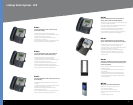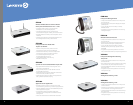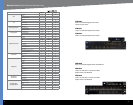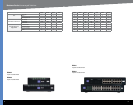
Roaming The ability to take a wireless device from one access point’s range to another without losing the connection.
Router A networking device that connects multiple networks together, such as a local network and the Internet.
RTP (Real-time Transport Protocol) A protocol that enables specialized applications, such as Internet phone calls, video, and audio,
to occur in real time.
RTS (Request To Send) A networking method of coordinating large packets through the RTS Threshold setting.
Server Any computer whose function in a network is to provide user access to files, printing, communications, and other services.
Snapshot A copy of a set of files, volumes, or directories as they were at a particular point in the past. The purpose of snapshot,
as utilized by the Linksys NSS devices, is that it provides a way that users can recover their own files without having to ask an IT
person to restore a backup. So for files that are on a volume for which snapshotting is enabled, a snapshot folder will be created
for each share. If the user decides they want to revert to an older version of the file, they can simply browse the snapshot folder
and find a version of the file that meets their needs. The snapshots can be set for hourly, daily and weekly intervals.
SNMP (Simple Network Management Protocol) A widely used network monitoring and control protocol.
Software Instructions for the computer. A series of instructions that performs a particular task is called a “program”.
SOHO (Small Office/Home Office) Market segment of professionals who work at home or in small offices.
SPI (Stateful Packet Inspection) Firewall A technology that inspects incoming packets of information before allowing them to
enter the network.
Spread Spectrum Wideband radio frequency technique used for more reliable and secure data transmission.
SSID (Service Set Identifier) Your wireless network’s name.
SSL (Secure Sockets Layer) An application layer security protocol used to provide authentication and communication privacy
of data transmitted over the Internet.
Static IP Address A fixed address assigned to a computer or device that is connected to a network.
Static Routing Forwarding data in a network via a fixed path.
Striping A method of concatenating multiple disk drives into one logical storage unit. Striping involves partitioning each drive’s
storage space into stripes which may be as small as one sector (512 bytes) or as large as several megabytes. These stripes are then
interleaved round-robin, so that the combined space is composed alternately of stripes from each drive. In effect, the storage space
of the drives is shuffled like a deck of cards. The type of application environment, I/O or data intensive, determines whether large
or small stripes should be used.
Subnet Mask An address code that determines the size of the network.
Switch 1. A device that that connects computing devices to host computers, allowing a large number of devices to share a
limited number of ports. 2. A device for making, breaking, or changing the connections in an electrical circuit.
TCP (Transmission Control Protocol) A network protocol for transmitting data that requires acknowledgement from the
recipient of data sent.
TCP/IP (Transmission Control Protocol/Internet Protocol) A network protocol for transmitting data that requires
acknowledgement from the recipient of data sent.
Telnet A user command and TCP/IP protocol used for accessing remote PCs.
Telnet A user command and TCP/IP protocol used for accessing remote PCs.
Throughput The amount of data moved successfully from one node to another in a given time period.
TFTP (Trivial File Transfer Protocol) A version of the TCP/IP FTP protocol that uses UDP and has no directory or password
capability.
TKIP (Temporal Key Integrity Protocol) A wireless encryption protocol that periodically changes the encryption key, making
it harder to decode.
TLS (Transport Layer Security) Is a protocol that guarantees privacy and data integrity between client/server applications
communicating over the Internet.
TX Rate Transmission Rate.
UDP (User Datagram Protocol) A network protocol for transmitting data that does not require acknowledgement from the
recipient of the data that is sent.
Unmanaged Switch A basic switch that works right out of the box and does not allow the user remote network administration
capability.
Upload To transmit a file over a network.
VOIP or IP Telephony Voice over Internet Protocol. Technology that enables people to use the Internet to transmit packets of
voice data using IP rather than traditional circuit transmissions. Seen as a more affordable voice solution for businesses.
VLAN (Virtual LAN) A network of computers that behave as if they are connected to the same wire, though they may actually
be physically located on different segments of a LAN.
VPN (Virtual Private Network) A security measure to protect data as it leaves one network and goes to another over the Internet.
WAN (Wide Area Network) A group of networked computers in a large geographical area. The best example of a WAN is the
Internet.
WEP (Wired Equivalency Protocol) WEP is a security protocol for wireless networks. WEP aims to provide security by encrypting
data over radio waves so that it is protected as it is transmitted from one end point to another. A shared key (similar to a password)
is used to allow communication between the computers and the router. WEP offers a basic, but satisfactory level of security for
wireless data transmission.
Wi-Fi A brandname of the Wi-Fi Alliance used to describe wireless LAN (WLAN) technology based on the IEEE 802.11 standards.
Wi-Fi Alliance A trade group that performs testing, develops specifications, certifies interoperability of products, and promotes
wireless networking technology. The Wi-Fi alliance owns the trademark to “Wi-Fi”.
WLAN (Wireless Local Area Network) A group of computers and associated devices that communicate with each other wirelessly.
WPA (Wi-Fi Protected Access) A security protocol for wireless networks that builds on the basic foundations of WEP. It secures
wireless data transmission by using a key similar to WEP, but the added strength of WPA is that the key changes dynamically. The
changing key makes it much more difficult for a hacker to learn the key and gain access to the network.
WPA2 (Wi-Fi Protected Access 2) WPA2 is the second generation of WPA security and provides a stronger encryption mechanism
through Advanced Encryption Standard (AES), which is a requirement for some government users.
WPA-Personal A version of WPA that uses long and constantly changing encryption keys to make them difficult to decode.
WPA-Enterprise A version of WPA that uses the same dynamic keys as WPA-Personal and also requires each wireless device to be
authorized according to a master list held in a special authentication server.
74 75


















